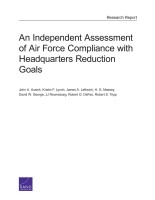| 来源类型 | Research Reports
|
| 规范类型 | 报告
|
| DOI | https://doi.org/10.7249/RR1480
|
| ISBN | 9780833094285
|
| 来源ID | RR-1480-AF
|
| An Independent Assessment of Air Force Compliance with Headquarters Reduction Goals |
| John A. Ausink; Kristin F. Lynch; James A. Leftwich; H. G. Massey; David W. George; Judy Roomsburg; Robert G. DeFeo; Robert S. Tripp
|
| 发表日期 | 2016
|
| 出版年 | 2016
|
| 页码 | 116
|
| 语种 | 英语
|
| 结论 |
The Air Force Achieved Its 20-Percent Reduction Goal and Used Sound Practices- We determined that the Air Force did achieve the 20-percent reductions in spending and end strength when using a technical count of positions coded with program element codes ending in 98. And all major commands contributed to the reductions.
- The Air Force approach to reducing its headquarters management functions included some examples of sound practices, such as identifying improved business processes that streamline information flow and eliminate work, eliminating or combining redundant organizations, and ensuring work is conducted at an appropriate organizational level. However, sound practices were not applied consistently across the Air Force; different major commands employed different strategies with differing results.
- We found that while additional opportunities to reduce major headquarters activities may exist, no areas stand out as immediate targets. Major commands have already eliminated low-priority activities and are currently addressing the residual adverse effects from those reductions. Process reengineering and other efficiencies identified during previous reduction efforts can provide targets for future reductions, but they will take time and detailed analyses from the Air Force.
|
| 摘要 |
- Looking to the future, core organizational design principles may offer targets of opportunity for future Air Force reductions. If the Air Force were to focus on consolidating like missions and using a matrix management approach to achieve economies of scale, several opportunities may be worth further evaluation. In addition, if the Air Force were to focus on opportunities to eliminate duplication and non–value added processes, it may find more opportunities for savings.
- Any initiative to reduce or streamline Air Force functions should be based on maintaining focus on the Air Force's strategic goals to ensure that organizational, process, or other changes do not lead to inefficient or ineffective processes or organizational structures.
- Before the next round of reductions, Headquarters Air Force should specify the strategic direction and approach to be used in the process. Whatever the approach may be, detailed process reengineering and analysis of options takes time. And there needs to be a senior leadership governance council appointed to oversee the process. Transparency of process and strategic communications will be essential to the success of any reorganization or reduction.
|
| 主题 | Civilian Military Workforce
; Military Budgets and Defense Spending
; United States Air Force
|
| URL | https://www.rand.org/pubs/research_reports/RR1480.html
|
| 来源智库 | RAND Corporation (United States)
|
| 引用统计 |
|
| 资源类型 | 智库出版物
|
| 条目标识符 | http://119.78.100.153/handle/2XGU8XDN/108310
|
推荐引用方式
GB/T 7714 |
John A. Ausink,Kristin F. Lynch,James A. Leftwich,et al. An Independent Assessment of Air Force Compliance with Headquarters Reduction Goals. 2016.
|
|
文件名:
|
x1495316298818.jpg
|
|
格式:
|
JPEG
|

|
文件名:
|
RAND_RR1480.pdf
|
|
格式:
|
Adobe PDF
|
除非特别说明,本系统中所有内容都受版权保护,并保留所有权利。